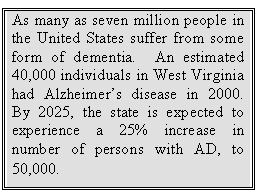PREVALENCE OF DEMENTIA
It is estimated that as many as seven million people in the United States suffer from some form of dementia (8). According to Older Americans 2000: Key Indicators of Well-Being (9), in 1998 about 4% of adults aged 65 to 69 had moderate to severe memory impairment (a measure of low cognitive functioning), compared with about 36% of adults aged 85 or older. The prevalence of low cognitive functioning was found to be slightly less among women aged 85 and older than among men of the same ages (35% and 37%, respectively). An estimated 5% to 8% of people aged 65 and older have some form of dementia; this number doubles for every five years over age 65.

Alzheimer’s disease alone affected approximately 4.5 million Americans in 2000 (10). Estimates of the annual number of new clinically diagnosed cases (incidence) of AD range from 250,000 to 360,000 (11,12). As the population ages, however, these numbers are expected to rise. Research presented in 2002 at the 8 th International Conference on Alzheimer’s Disease and Related Disorders (ICAD) and published in the August 2003 issue of the Archives of Neurology makes dire predictions about the future of AD in the United States (10). Evans et al., the study’s authors, based their findings on data from the Chicago Health and Aging Project, which was supported by the National Institutes of Health. They project that by 2050 an estimated 13.2 million Americans will have AD if nothing is done to forestall or treat the disease. The table below shows these projections, in millions, by age group:
Year |
Ages 65-74 |
Ages 75-84 |
Ages 85+ |
Total |
2000 |
0.3 |
2.4 |
1.8 |
4.5 |
2010 |
0.3 |
2.4 |
2.4 |
5.1 |
2020 |
0.3 |
2.6 |
2.8 |
5.7 |
2030 |
0.5 |
3.8 |
3.5 |
7.7 |
2040 |
0.4 |
5.0 |
5.6 |
11.0 |
2050 |
0.4 |
4.8 |
8.0 |
13.2 |
The situation is even more serious among minorities. Research reported at the 9 th ICAD held in 2004 suggested that minorities were underrepresented in the study by Evans et al. and thus will face an even greater problem if interventions to prevent and treat AD are not implemented. A University of Pennsylvania study found that AD symptoms first appeared at an average age of 67.6 in Latinos, compared with 73.1 among non-Latinos (13). In another study presented at the conference, researchers found much higher rates of AD among African-Americans than among whites (14). The study was conducted in South Carolina, one of only two states that keep an Alzheimer’s registry. Among persons aged 55-64, the rate of AD was more than three times higher among blacks than whites; among persons aged 65 to 84 the rate was more than double and in persons over the age of 85, blacks were 1.5 times more likely to be diagnosed with AD.
Evans et al. expanded their study to include state-specific projections of AD prevalence through 2025 and published their results in Neurology in 2004. For West Virginia, their model produced an estimate of 40,000 affected individuals in 2000. By 2025, the state is expected to experience a 25% increase in number of persons with AD, to 50,000 (15).
A 1998 study by Brookmeyer et al. estimated the 1997 prevalence of AD at 2.3 million (1.09 to 4.58), a more conservative estimate than that derived from the Evans et al. model (12). Published in the American Journal of Public Health in 1998, the authors projected that the prevalence of Alzheimer’s would quadruple by 2047, afflicting approximately 1 in 45 Americans at that time if steps were not taken to delay onset. According to their research, if interventions could be implemented that would delay the onset of AD by two years, there would be 2 million fewer cases in 2047. The delay of symptoms by just one year would result in 800,000 fewer cases.